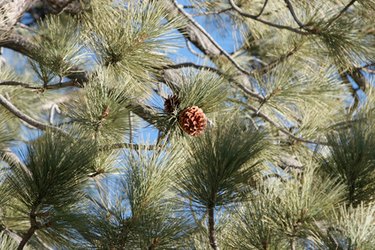
The leaves of many kinds of conifers take the form of spindly, needle-like structures. Those of most spruces, firs and hemlocks are stubby and densely packed. Pine trees, by contrast, often sport relatively long needles that give their boughs a woolly, ragged appearance. These striking sprays of foliage, along with typically airy canopies and ragged, patchy bark, can make pines stand out even against surroundings of other conifers. North America has a number of species of pine with very long needles, often their most distinctive trait.
The Longleaf Pine
Video of the Day
The eastern U.S. has many native pine species, including a fair number of long-needled ones. This characteristic is inherent in the name of the longleaf pine, an important conifer of Southeastern sandhills and uplands that often grows in open savannas. This long-lived species has needles up to 18 inches long. The circular, bristling tufts of these lengthy leaves are diagnostic and easily discerned from a distance.
Video of the Day
Other Eastern Pines
Three other Southeastern pines also have significantly long needles: The pond, loblolly and slash pines all grow leaves 7 inches or more. In the Midwest and Northeast, the red pine may grow needles 5 inches or better in length, giving its foliage a rounder, shaggier appearance than that of the eastern white and jack pines it often grows amongst.
The Ponderosa Pine
While many pines of the West are fairly short-needled, one of the most widely distributed is a prominent exception. The stately ponderosa pine, which grows from the Black Hills to the Pacific ranges, may have needles up to 8 inches in length. Its large leaf bundles and crimson, plated bark set it apart from common associates like Douglas fir and white fir. The closely related and very similar-looking Jeffrey pine, which often replaces ponderosa in colder, drier or nutrient-poor sites in southern Oregon and the Sierra Nevada, has needles of analogous length.
Other Westerners
Some of the pines of California have even longer needles: better than 9 inches for the Coulter (of coastal chaparral), ghost (of interior foothills) and Torrey (highly restricted in Southern California) species. In southeastern Arizona and southwestern New Mexico, you may spot Arizona and Apache pines with needles of 7 inches and more than a foot long, respectively.
Other Species
Some pines from other parts of the world and commonly cultivated in parts of North America, like the maritime and Bhutan pines, have fairly long needles. Other conifer species usually have substantially smaller needles, but those of some larches, Deodar cedars and certain others may be relatively longer than those of typical spruces and firs, usually an inch or less in length.